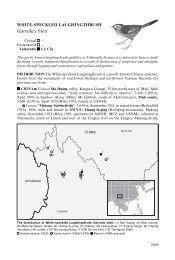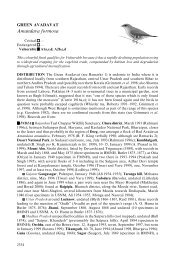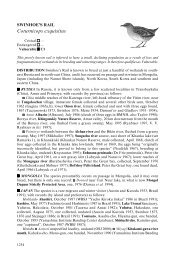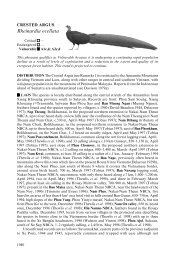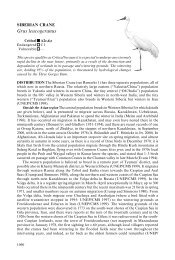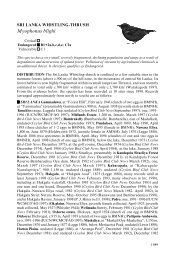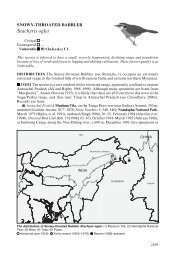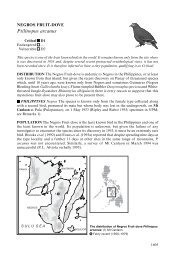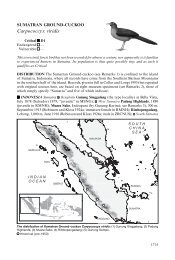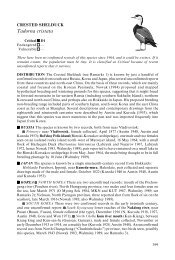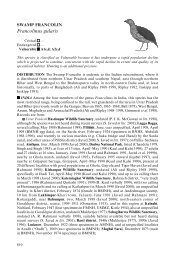Gyps bengalensis - BirdBase
Gyps bengalensis - BirdBase
Gyps bengalensis - BirdBase
Create successful ePaper yourself
Turn your PDF publications into a flip-book with our unique Google optimized e-Paper software.
<strong>Gyps</strong> <strong>bengalensis</strong><br />
initiated to assess levels of genetic diversity; (4) studies should be carried out to search for<br />
potential pathogens causing disease in vultures; (5) captive breeding programmes should be<br />
initiated (Prakash 1999a). In fact, this package of measures can be extended under the<br />
following headings.<br />
Population surveys Detailed surveys are required to monitor the status of this and other<br />
species of vulture (Rahmani and Prakash 2000a). In India, BNHS is coordinating surveys<br />
and population monitoring through the Indian Bird Conservation Network, and further<br />
surveys are planned during November–December 2000 and 2001 in and around all protected<br />
areas, in conjunction with the wetland and waterfowl survey of the Salim Ali Centre for<br />
Ornithology (SACON), Coimbatore; these organisations plan to develop a simple sampling<br />
protocol surveys (Rahmani and Prakash 2000b). It has been suggested that the vast manpower<br />
available through the forest department could facilitate surveys (Rahmani and Prakash 2000b).<br />
In Nepal and Pakistan, surveys will be carried out through collaboration between the Peregrine<br />
Fund, Ornithological Society of Pakistan, and Bird Conservation Nepal (P. Wood in litt.<br />
2000). The British Vulture Conservation Society is coordinating the compilation of a database<br />
of people and organisations who can contribute to monitoring vulture populations (P. Wood<br />
in litt. 2000).<br />
Ecological studies Focused ecological studies will be carried out by a range of organisations<br />
(including BNHS, SACON, and the Wildlife Institute of India) at 11 sites (Keoladeo, Buxa,<br />
Kutch, Bandhavgarh, Nagarhole, Harike, Ranikhet, Kukrail, Pench, Ladakh and Kota),<br />
and the factors to be studied will include population age structure, breeding attempts, fledging<br />
success, levels of human disturbance, food availability, incidence of disease symptoms and<br />
mortality rates (Rahmani and Prakash 2000b). In Nepal, such projects will be set up at<br />
vulture colonies through collaborations between the Peregrine Fund and Bird Conservation<br />
Nepal (M. A. Virani in litt. 2000).<br />
Laboratory studies Although the preliminary data suggest that an infectious disease caused<br />
by a viral agent is the likely cause of the vulture population crashes, other factors should<br />
continue to be investigated (Rahmani and Prakash 2000b). Searches are still under way to<br />
locate local laboratories that could determine cholinesterase activity levels, which are a measure<br />
of exposure to organophosphate and carbamate insecticides (Risebrough 1999).<br />
Characterisation of the disease factor would be hastened by the collaboration of additional<br />
international laboratories (Risebrough 1999). Tissue samples from vulture carcasses collected<br />
from areas other than the Keoladeo National Park are required (Risebrough 1999). Studies<br />
are required in order to identify diagnostic measures of infection other than the behavioural<br />
symptoms (head-drooping) that have already been documented (Risebrough 1999).<br />
Further post-mortems and tissue-sample screening for vulture mortalities will be carried<br />
out through collaboration between BNHS, laboratories in India and the Zoological Society<br />
of London (P. Wood in litt. 2000). In Pakistan, post-mortems are being carried out on dead<br />
vultures found in Kundian forest (M. Nasir in litt. 2000). Further work at the Poultry<br />
Diagnostic and Research Centre, Pune, will focus on attempting to isolate and DNAsequence<br />
the viral pathogen (Rahmani and Prakash 2000b). Identification of the virus is also<br />
being attempted at the National Virology Laboratory, Pune (Rahmani and Prakash 2000b).<br />
In Nepal healthy and sick birds will be trapped to collect blood and tissue samples for<br />
laboratory analysis in order to isolate the disease factor and to develop a vaccine (M. A.<br />
Virani in litt. 2000).<br />
Captive breeding An inventory of captive populations in zoos throughout the world is<br />
required in order to determine the number of individuals and their health (Risebrough 1999).<br />
These captive individuals should be protected from exposure to recently wild-caught birds in<br />
order to prevent potential disease transmission (Risebrough 1999). Any apparently healthy<br />
captive individuals may well prove to be priceless for the conservation of these species<br />
(Risebrough 1999), because the population crashes appear to have been so catastrophic that<br />
611



